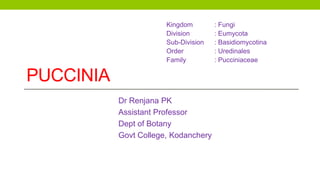Puccinia
- 1. PUCCINIA Kingdom : Fungi Division : Eumycota Sub-Division : Basidiomycotina Order : Uredinales Family : Pucciniaceae Dr Renjana PK Assistant Professor Dept of Botany Govt College, Kodanchery
- 5.  Rusts  Obligate parasite  Autoecoius or heteroecius  P. graminis – Black rust/stem of wheat Two hosts- heteroecious – Primary host & alternate host Wheat (Dikaryophase) Barberry (Haplophase)
- 6. Uredineal stage Telial stage Basidial stage Pycnidial/ spermagonial Aecidial stage WHEAT BARBERRY
- 7. UREDINEAL STAGE ÔÉò Formed by the germination of aeceidiospore on wheat ÔÉò A uredosorus is formed ÔÉò Binucleate, oval to round ÔÉò Reddish brown pustles- Red stage ÔÉò Means of secondary infection
- 9. TELIALSTAGE ÔÉò Formed by the gradual replacemnt of uredosori ÔÉò Black stage, teleutospore ÔÉò 2-celled, binucleate, clavate ÔÉò Thick & smooth walls ÔÉò Undergo a period of rest ÔÉò The 2 nuclei fuse to form a diploid nucleus
- 13. BASIDIAL STAGE ÔÉò Germination of teleutospore ÔÉò Promycelium becomes the basidium ÔÉò 4 basidiospores by meiosis ÔÉò Germinates on Barberry ÔÉò Forms the haplomycelium ÔÉò Produces pycnidium on stage on upper side & aecidium on lower side
- 14. PYCNIDIAL/SPERMA GONIAL STAGE ÔÉò Flask shaped pycnidium/spermagoniu m on the upperside ÔÉò Ostiole & periphyses ÔÉò Palisade like spermatial hyphae ÔÉò Non moile single celled spermatia ÔÉò Long receptive hyphae ÔÉò Transfer of spermatium of one strain to receptive hyphae of another strain ÔÉò A binucleate cell is formed
- 17. AECIDIAL STAGE ÔÉò Dikaryotic mycelium organises cup shaped structures ÔÉò Lower side, peridium (wall) ÔÉò Aecidiospores in basipetal succession ÔÉò Intercalary cells ÔÉò Binucleate, thick walled ÔÉò Sub globose to polyhedral ÔÉò Liberated aecidiospores germinate on wheat plants




















